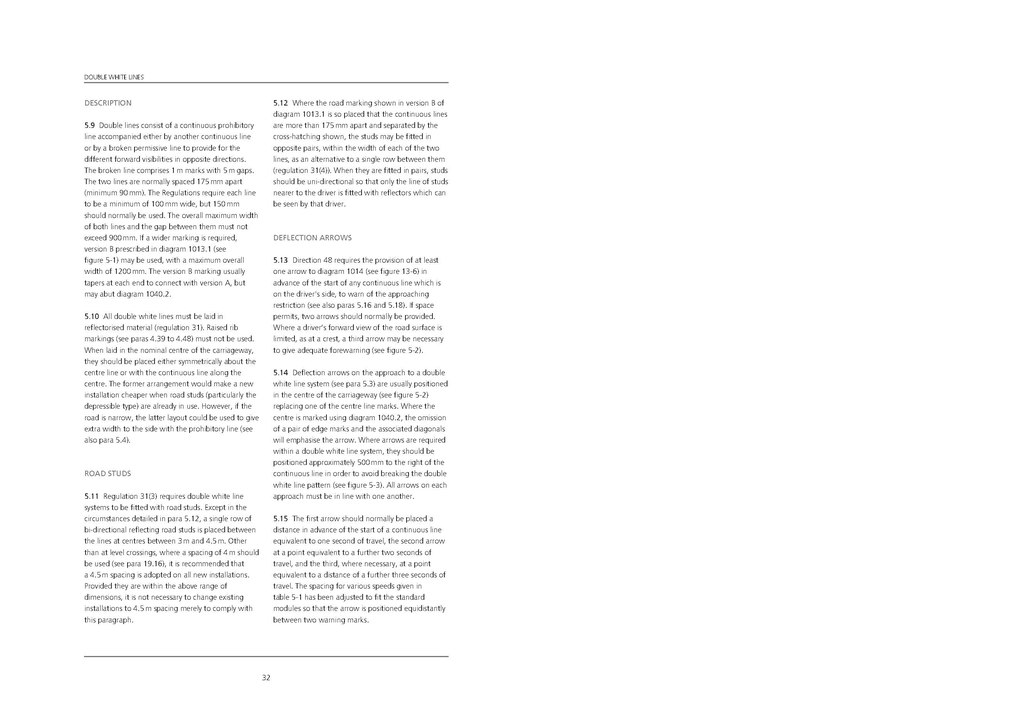DESCRIPTION
5.9 Double lines consist of a continuous prohibitory line accompanied either by another continuous line or by a broken permissive line to provide for the different forward visibilities in opposite directions. The broken line comprises 1 m marks with 5 m gaps. The two lines are normally spaced 175 mm apart (minimum 90 mm). The Regulations require each line to be a minimum of 100 mm wide, but 150 mm should normally be used. The overall maximum width of both lines and the gap between them must not exceed 900 mm. If a wider marking is required, version B prescribed in diagram 1013.1 (see figure 5-1) may be used, with a maximum overall width of 1200 mm. The version B marking usually tapers at each end to connect with version A, but may abut diagram 1040.2.
5.10 All double white lines must be laid in reflectorised material (regulation 31). Raised rib markings (see paras 4.39 to 4.48) must not be used. When laid in the nominal centre of the carriageway, they should be placed either symmetrically about the centre line or with the continuous line along the centre. The former arrangement would make a new installation cheaper when road studs (particularly the depressible type) are already in use. However, if the road is narrow, the latter layout could be used to give extra width to the side with the prohibitory line (see also para 5.4).
ROAD STUDS
5.11 Regulation 31(3) requires double white line systems to be fitted with road studs. Except in the circumstances detailed in para 5.12, a single row of bi-directional reflecting road studs is placed between the lines at centres between 3 m and 4.5 m. Other than at level crossings, where a spacing of 4 m should be used (see para 19.16), it is recommended that a 4.5 m spacing is adopted on all new installations. Provided they are within the above range of dimensions, it is not necessary to change existing installations to 4.5 m spacing merely to comply with this paragraph.
5.12 Where the road marking shown in version B of diagram 1013.1 is so placed that the continuous lines are more than 175 mm apart and separated by the cross-hatching shown, the studs may be fitted in opposite pairs, within the width of each of the two lines, as an alternative to a single row between them (regulation 31(4)). When they are fitted in pairs, studs should be uni-directional so that only the line of studs nearer to the driver is fitted with reflectors which can be seen by that driver.
DEFLECTION ARROWS
5.13 Direction 48 requires the provision of at least one arrow to diagram 1014 (see figure 13-6) in advance of the start of any continuous line which is on the driver's side, to warn of the approaching restriction (see also paras 5.16 and 5.18). If space permits, two arrows should normally be provided. Where a driver’s forward view of the road surface is limited, as at a crest, a third arrow may be necessary to give adequate forewarning (see figure 5-2).
5.14 Deflection arrows on the approach to a double white line system (see para 5.3) are usually positioned in the centre of the carriageway (see figure 5-2) replacing one of the centre line marks. Where the centre is marked using diagram 1040.2, the omission of a pair of edge marks and the associated diagonals will emphasise the arrow. Where arrows are required within a double white line system, they should be positioned approximately 500 mm to the right of the continuous line in order to avoid breaking the double white line pattern (see figure 5-3). All arrows on each approach must be in line with one another.
5.15 The first arrow should normally be placed a distance in advance of the start of a continuous line equivalent to one second of travel, the second arrow at a point equivalent to a further two seconds of travel, and the third, where necessary, at a point equivalent to a distance of a further three seconds of travel. The spacing for various speeds given in table 5-1 has been adjusted to fit the standard modules so that the arrow is positioned equidistantly between two warning marks.
32
